Abstract
There has been recent growth in small area estimation due to the need for more precise estimation of small geographic areas, which has led to groups such as the U.S. Census Bureau, Google, and the RAND corporation utilizing small area-estimation procedures. We develop a novel two-stage benchmarking methodology using a single weighted squared error loss function that combines the loss at the unit level and the area level without any specific distributional assumptions. This loss is considered while benchmarking the weighted means at each level or both the weighted means and weighted variability at the unit level. Furthermore, we provide multivariate extensions for benchmarking weighted means at both levels. The behavior of our methods is analyzed using a complex study from the National Health Interview Survey (NHIS) from 2000, which estimates the proportion of people that do not have health insurance for many domains of an Asian subpopulation. Finally, the methodology is explored via simulated data under the proposed model. Ultimately, three proposed benchmarked Bayes estimators do not dominate each other, leaving much exploration for further understanding of such complex studies such as the choice of weights, optimal algorithms for efficiency, as well as extensions to multi-stage benchmarking methods.
Similar content being viewed by others
References
Wang J, Fuller WA, Qu Y (2008) Small area estimation under a restriction. Surv Methodol 34:29–36
Ugarte MD, Goicoa T, Militino AF (2009) Benchmarked estimates in small areas using linear mixed models with restrictions. Test 18:342–364
Battese G, Harter R, Fuller W (1988) An error-components model for prediction of county crop area using survey and satellite data. J Am Stat Assoc 83:28–36
Datta GS, Ghosh M, Steorts R, Maples J (2011) Bayesian benchmarking with applications to small area estimation. Test 20(3):574–588
Bell WR, Datta GS, Ghosh M (2013) Benchmarked small area estimators. Biometrika 100(1):189–202
Ghosh M, Kim D, Sinha K, Maiti T, Katzoff M, Parsons V (2009) Hierarchical and empirical Bayes small domain estimation of the proportion of persons without health insurance or minority subpopulations. Surv Methodol 35(1):53–66
Ghosh M, Natarajan K, Stroud T, Carlin B (1998) Generalized linear models for small area-estimation. J Am Stat Assoc 93(441):53–66
Isaki CT, Tsay JH, Fuller WA (2004) Weighting sample data subject to independent controls. Surv Methodol 20:35–44
Acknowledgements
This research was partially supported by the United States Census Bureau Dissertation Fellowship Program and NSF Grants SES 1026165 and SES 1130706. The views expressed reflect those of the authors and not of the National Health Interview Survey, the United States Census Bureau, or NSF. We would like to express our thanks to the Associate Editor and referees for their helpful suggestions.
Author information
Authors and Affiliations
Corresponding author
Appendix
Appendix
The first plot shows \(\hat{\delta}_{i}^{I}- \hat{\delta}_{i}^{B}\) and \(\hat{\delta}_{i}^{C}- \hat{\delta}_{i}^{B}\) versus domain sample size n i , illustrating that the estimator \(\hat{\delta}_{i}^{C}\) is not desirable. The middle plot shows \(\hat{\delta}_{i}^{I}- \hat{\delta }_{i}^{B}\) and \(\hat{\delta}_{i}^{n}- \hat{\delta}_{i}^{B}\) versus domain sample size n i , while the last plot shows \(\hat{\delta }_{i}^{R}- \hat{\delta}_{i}^{B}\) and \(\hat{\delta}_{i}^{n}- \hat{\delta}_{i}^{B}\) versus domain sample size n i
On the left, we plot the difference \(\hat{\delta}_{i}^{R}- \hat {\delta}_{i}^{B}\) versus n i for the simulated and NHIS data. We also plot the difference \(\hat {\delta}_{i}^{I}- \hat{\delta}_{i}^{B}\) versus n i for the simulated and NHIS data which corresponds to the middle plot. We plot the same for \(\hat{\delta}_{i}^{n}-\hat{\delta }_{i}^{B}\) on the right. All three plots illustrate similar behavior for the simulated data as the NHIS data
The figure on the left plots the % increase in PRMSE of the raked estimator under the NHIS and the simulated data versus the domain sample size. This plot illustrates that under both data sources there is more spread as the inverse-variance estimator increases. The middle figure plots the % increase in PRMSE of the inverse-variance estimator under the NHIS data (circles) and the simulated data (plusses) versus the domain sample size, while the right-hand plot does the same for the domain-weighted inverse-variance estimator
The figure on the left plots a kernel density estimate of the difference of the inverse estimator calculated under (i) the NHIS data and (ii) the simulated data. The figure on the right does this for the raked estimator. Both plots illustrate that the posterior mean of the difference of the densities is centered near 0, with the function being unimodal
Rights and permissions
About this article
Cite this article
Ghosh, M., Steorts, R.C. Two-stage benchmarking as applied to small area estimation. TEST 22, 670–687 (2013). https://doi.org/10.1007/s11749-013-0338-2
Received:
Accepted:
Published:
Issue Date:
DOI: https://doi.org/10.1007/s11749-013-0338-2









